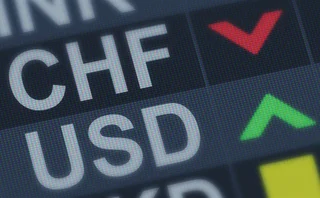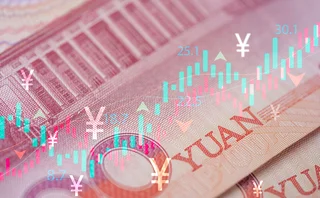

New hope for crypto derivatives as markets urged to hail CESR
Ethereum staking index could allow swap curve and structured products to develop
Need to know
- The Composite Ether Staking Rate which tracks the yields earned by members of the Ethereum blockchain, could enable the creation of investment products uncorrelated to traditional markets.
- CoinDesk Indices and CoinFund have formed a partnership to offer CESR, which would allow Ethereum’s ‘validators’ to swap their variable income for US dollars at a fixed rate.
- The benchmark’s creators expect family offices and hedge funds to show interest in the risk premium and right-way risk that would come from receiving exposure to a floating staking yield in Ethereum’s cryptocurrency, ether.
- Lido and Compass Financial Technologies have developed similar rates. Markets in exchange-traded and structured products could develop, with institutions likely to want the total return exposure of ETH.
- FalconX, a crypto-native market-maker and registered swap dealer in the US, expects an interdealer market to grow over time.
Last September, Ethereum crossed the Rubicon. The blockchain, which had until then operated under a proof-of-work (Pow) architecture similar to those underpinning cryptocurrencies such as bitcoin, switched to an entirely new mechanism known as proof of stake (Pos).
Under the old system, block creators known as ‘miners’ would be given Ethereum’s cryptocurrency ether (ETH) in return for decrypting hexadecimal numerical codes. Under Pos, members of the network – now known as ‘validators’ – stake their ETH tokens into a smart contract, which enables them to earn fees by confirming transactions. The tokens can be destroyed if the validators behave improperly.
The transition also triggered what CoinFund president Chris Perkins says was a “light bulb” moment for his digital asset investment firm. Perkins saw that the fees validators would earn could wax and wane depending on the level of demand on the network. Surprising market events, like the collapse of crypto exchange FTX, could cause spikes in demand and lead to higher fees.

I’m hopeful we can build social consensus that CESR is the standard benchmark for Ethereum staking. Once we have social consensus, the industry – both trad-fi and crypto – can build
Chris Perkins, CoinFund
Perkins realised that validators, like any businesses with variable income and fixed costs, would need a way to hedge their financial exposure, and so he joined forces with CoinDesk Indices to launch the Composite Ether Staking Rate (CESR), which tracks the yields validators earn. The benchmark – pronounced in the same way as the Roman emperors – could also enable validators to enter into swap contracts whereby they would exchange CESR for a fixed rate, thus locking in their profits.
Perkins says CESR, as a staking yield index, is a “non-correlated rate to traditional finance”. He believes certain investors, such as hedge funds and family offices, might use it to achieve a stream of returns unconnected to conventional asset classes – such as bonds and equities, the values of which can fluctuate in reaction to changes in the US Federal Reserve’s monetary policy.
Andy Baehr, managing director at CoinDesk Indices, says using CESR as a settlement rate will support a fixed-versus-floating swap market that lines up natural users on both sides. He believes validators could experience less volatility in their revenue by swapping their variable staking yield for a fixed rate.
“The other side of the trade – receiving floating – could carry a risk premium and could be incorporated into investor products,” he says. “Due to the natural convexity of Ethereum staking yields, dealers may find that holding on to floating inventory is, in a sense, right-way risk.
“The question is, where is that fixed rate going to trade? That comes down to what fixed payments validators will be happy to receive to give away that convexity in service of improving the Sharpe ratio of their stake.”
In the arena
CESR is not the only staking yield index that market participants have looked at. Switzerland-based Compass Financial Technologies has been working with exchange-traded product (ETP) issuers to use its own staking yield rate as a base yield in ETH products. Compass is a European Union-approved benchmark administrator, and its STYETH index is approved for use in regulated products in the bloc.
ETPs could use swaps based on staking yield indices to give investors a total return on ETH.
So far, most crypto ETPs simply give investors exposure to the performance of ETH. Guillaume Le Fur, Compass’s CEO, says some ETP providers have begun to offer clients a fixed staking yield on top of that. However, this is typically at the discretion of the asset manager. Compass has been working with issuers to incorporate the returns from its index into the products.
ETPs come with liquidity management issues. With ETH, unlike some coins on Pos blockchains, there is no minimum period of days during which the currency must be staked. However, ETH does have an entry queue: it currently takes around 31 days to stake the currency but only one minute to exit. Based on that, an ETP could not at any time stake 100% of its ETH holdings as it would have to manage daily liquidity requirements.
ETPs keep as profit the margin between the actual staking rate and what the client receives. Although this is currently acceptable to retail investors, Le Fur thinks that if more institutions are to be attracted to the market they will want the total return exposure.
Another use case is structured products. Chris Bae, founder and chief executive of Enhanced Digital Group, says CESR could be used for a classic zero-coupon bond structure, where the reference rate is used as the pull-to-par by maturity. The difference at inception could be used to buy ETH options that provided customised payoffs.
“It just opens the yield world beyond securities lending,” he says. “It’s actually a yield that we can grasp from the validators. And then all of a sudden – if you can build on it, put notes on it and financialise it – it’s a really tangible hurdle and interest rate for the ETH ecosystem. Validators may be willing to swap up a considerable percentage of their received staking yields for fixed US dollars to pay for things like expenses or loan costs.
“Interest in structured products in general has gone up as interest rates have risen. But with US Treasuries paying more than 5%, the overall macro environment provides a lot of choices for competitive yields."
Greg Schvey, CEO of market infrastructure technology company Axoni, says CESR could provide transparency around staking services, and thereby enable users of those services to “understand the spread they’re paying the service provider by comparing to the benchmark rate”.
He adds: “Given the inherent transparency provided by the blockchain, it would also help prevent the manipulation and related issues we’ve seen in Libor.”
Not everyone is convinced about CESR’s merits. Max Boonen, founder of digital asset liquidity provider B2C2, believes it is too early for the benchmark to take off. “There could be demand for the rate if it’s freely accessible and a licensing fee doesn’t need to be paid,” he says. “But more of a market around the actual act of staking is needed before we have data providers and the like on top.
“We don’t really have much in the way of convenient user interfaces with staking. It tends to be a little bit convoluted because you need to go deep in the technology. Some exchanges offer staking as a service, but I think we’re only at the beginning of that industry.”
Given the inherent transparency provided by the blockchain, [CESR] would also help prevent the manipulation and related issues we’ve seen in Libor
Greg Schvey, Axoni
However, Perkins says CoinFund does not mind being early and that it has responded to the feedback of finance and academia by engineering a benchmark that is robust, institutional and investible. He adds that CESR is transparent and replicable – enabling industry stakers to compete against the mean.
“This sort of transparency should be a good thing for markets,” he says. “I’m hopeful we can build social consensus that CESR is the standard benchmark for Ethereum staking. Once we have social consensus, the industry – both trad-fi and crypto – can build.”
When in ETH, do as the ETH traders do
One crypto-native market-maker is already on board with CESR.
Ryan Kim is head of derivatives at California-based FalconX, which is the only crypto-native firm registered as a swap dealer with the US Commodities and Futures Trading Commission. He sees demand for a contract where the CESR rate is denominated in ETH, with the USD/ETH exchange rate locked in at the outset, so both the fixed and floating legs can be exchanged in dollars. Under that scenario, Kim says FalconX could manage the USD/ETH risk, though he adds that the validators would probably want to receive the fixed leg in dollars so they could use it to pay for business or loan expenses.
“What they can do is come to FalconX and say ‘I will give you every month my ETH production at the rate that is the average rate,’” he says. “‘And in exchange, you will give me a set number of dollars every month.’ I have now completely taken out the uncertainty involved with this loan. And I now know I have this stream of dollar payments no matter what the price of ETH does, and as long as I beat the average I will have that ETH on hand to deliver to Falcon X.”
Kim says a typical tenor would be six months, with monthly coupon payments, and a typical notional size would be around $250 million. Initially, he expects most interest to come from the validator side – which would mean FalconX, as a market-maker, having to find a way to hedge – though he also expects an interdealer market in the swaps to grow over time.
Perkins is confident other market-makers will get involved. Over time, he believes swap trading on the benchmark will allow for the development of a term curve, which asset managers could use as a discount curve to value their ETH assets.
Last year, staking yield swaps were also attempted on Lido, a benchmark that takes in just under 30% of the total number of validators. However, while this rate is based on what Lido itself produces, Perkins says CESR is based on data from the entire Ethereum blockchain – more than 750,000 validators – “rather than a subset”.
Compass says STYETH also follows all on-chain validators worldwide.
Empire building
Banks have so far been slow to take interest in CESR. Although Perkins detects curiosity from their research departments, he says traders are taking longer to “digest” the benchmark. Basel capital rules mean a punitive 1,250% risk weight can be applied to holding crypto assets such as bitcoin or ETH on bank balance sheets.
Perkins characterises CESR as “a synthetic version once removed”, as it does not reference ETH’s underlying price. “If I was at a bank, I would definitely be working closely with my capital people to see if there’s a structure upon which this could fit into the rates bucket,” he says.
Perkins, who was previously global co-head of futures, clearing and FX prime brokerage at Citi, is working with the International Swaps and Derivatives Association on updating its crypto definitions, which do not cover swaps. He believes there may be more interest in CESR from banks once ETH celebrates its 10th birthday in 2025: “That’s a nice institutional unlock when you have 10 years of risk data.”
CESR went into production on September 15 last year after CoinDesk and Coinfund had finalised its methodology. Perkins expects more interest from regulated exchanges once it has amassed more than 12 months of historical data. He says that, as a truly global rate, it compares favourably with overnight index swap rates that are split up by jurisdiction, such as Eonia and Sonia.
CESR is currently calculated once a day, seven days a week, based on a look-back period of 24 hours, but it has the potential to move to hourly releases. Initially offered in the US only, the benchmark is expected to go fully live later this month, with trades announced shortly afterwards.
Bae of Enhanced Digital Group admits that a “beautiful seamless curve” will not emerge immediately. He likens the evolution required for CESR to the forward curve for China’s offshore renminbi in Hong Kong, which took two years to develop.
“CNH was really hard to adopt,” he says. “People were like, ‘Well, I don’t know why I want to trade that yet.’ It was just one week and one month for a long time. And then it got to three months.” He adds that a turning point that made the curve more tradeable was an increase in CNH-denominated bonds issued by Hong Kong corporates. He does, however, see definite uses cases for CESR.
Perkins says the benchmark is also “a pretty beautiful on-ramp into crypto for rates”, as it would enable cross-currency swaps with fiat currencies or floating-for-floating basis swaps, such as SOFR against CESR.
“If you have a view that traditional interest rates are going down and activity in Ethereum is going up,” he says, “maybe you go long CESR and short SOFR.”
It remains to be seen whether CESR will prove as all-conquering as its namesake. Rome was not built in a day but there are now, it seems, more roads leading to crypto derivatives.
Editing by Daniel Blackburn
Only users who have a paid subscription or are part of a corporate subscription are able to print or copy content.
To access these options, along with all other subscription benefits, please contact info@risk.net or view our subscription options here: http://subscriptions.risk.net/subscribe
You are currently unable to print this content. Please contact info@risk.net to find out more.
You are currently unable to copy this content. Please contact info@risk.net to find out more.
Copyright Infopro Digital Limited. All rights reserved.
You may share this content using our article tools. Printing this content is for the sole use of the Authorised User (named subscriber), as outlined in our terms and conditions - https://www.infopro-insight.com/terms-conditions/insight-subscriptions/
If you would like to purchase additional rights please email info@risk.net
Copyright Infopro Digital Limited. All rights reserved.
You may share this content using our article tools. Copying this content is for the sole use of the Authorised User (named subscriber), as outlined in our terms and conditions - https://www.infopro-insight.com/terms-conditions/insight-subscriptions/
If you would like to purchase additional rights please email info@risk.net
More on Markets
SG trader dismissals shine spotlight on intraday limit controls
Risk experts say many banks rely on daily reports and can’t effectively monitor intraday limits in real time
Hedge funds’ pricing often trumps other buy-siders – SNB
Research shows “advantageous” prices result in outperformance of 139bp trading USD/CHF
Softer FX rules for China QFIs set to boost CNY competition
Freedom to circumvent local custodians a plus for pricing and best execution – State Street
Allianz Life drops single-name CDS positions in Q4
Counterparty Radar: US life insurance industry volumes sink to lowest level in two years
Sustainable bond markets miss an options trick
A derivatives mindset could boost lagging sustainability-linked market, argues climate think-tank
FX dealers face end-of-day trading stress from T+1 shift
Experts say switch to using overnight swaps could be “problematic” and lead to wider spreads
Consortium backs BGC’s effort to challenge CME
Banks and market-makers – including BofA, Citi, Goldman, Jump and Tower – will have a 26% stake in FMX
Natixis turns on the taps in flow trading
French bank boosts flow business, balancing structured solutions capabilities
Most read
- Industry urges focus on initial margin instead of intraday VM
- For a growing number of banks, synthetics are the real deal
- Did Fed’s stress capital buffer blunt CCAR?







